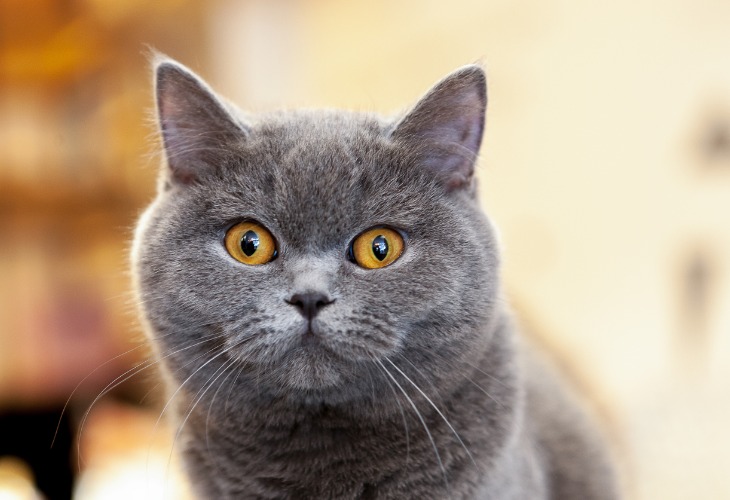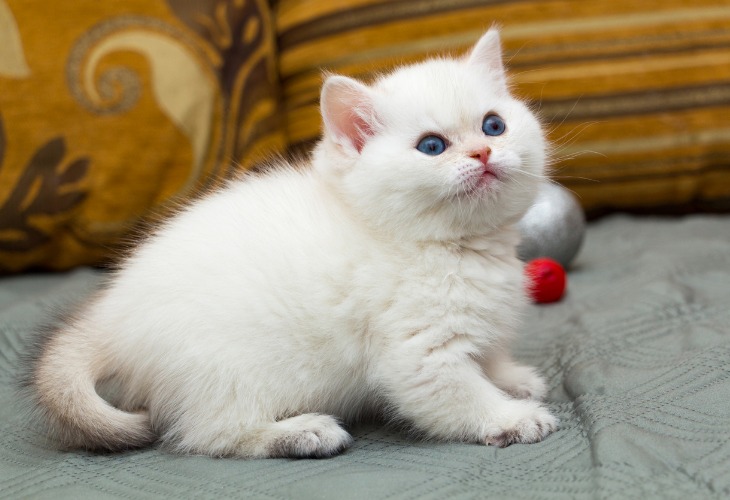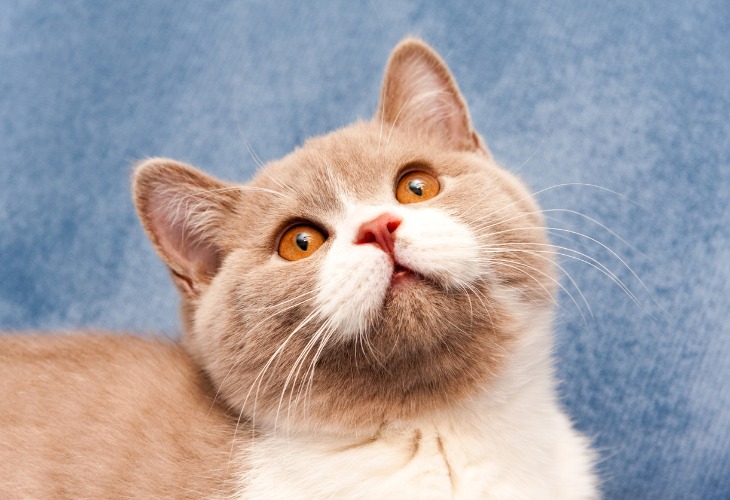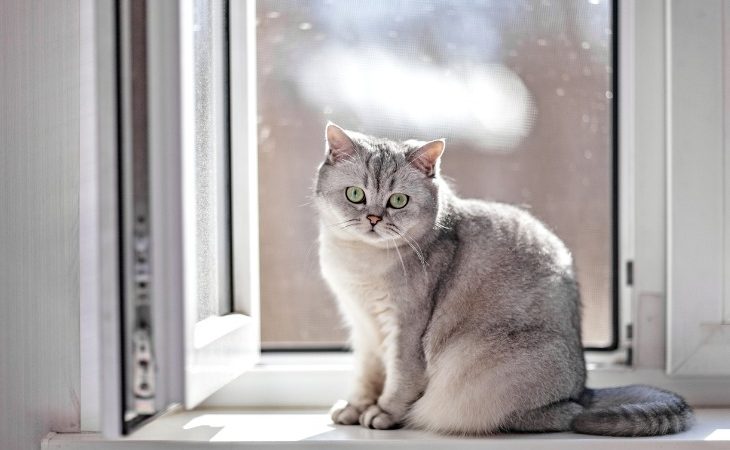Breed standard: CFA, FIFe, TICA, WCF, FFE, AACE, ACF, ACFA/CAA, CCA-AFC I Size: Medium/Large I Average lifespan: 15+ years I Temperament: Easygoing and playful I Coat: Short/Medium length hair I Origin: United Kingdom
The British Shorthair is a sweet-natured, affectionate, gentle, and intelligent cat breed.
The British Shorthair: the shift from alley cat to pedigree cat
British alley cat
As its name clearly suggests, the British Shorthair is native to Great Britain. Originally a simple alley cat, the breed was developed from cats without any pedigree.
The British Shorthair’s ancestors strongly resembled the Chartreux. In 1871, a number of English breeders, such as Harrison Weir, decided to display them at the first-ever cat show at the Crystal Palace in London.
The British Shorthair is in a way the equivalent of the American Shorthair in the United States and the European Shorthair in Europe.
At the very beginning of the 20th century, in 1901, the Short-Haired Cat Society was created for enthusiasts of the breed.
Twentieth-century: the endangerment of the British Shorthair
Following the First World War, many British Shorthair breeding facilities disappeared. This led to a shortage of the breed. In an effort to preserve their existance, breeders decided to crossbreed the British Shorthair with cats without pedigree. However, these various crossings modified the initial physique of the British which lost its roundness. They were then crossbred with Persians to re-establish the true appearance of the breed.
Unfortunately, crossbreeding also had its consequences. The GCCF (Governing Council of the Cat Fancy) decided to refuse the registration of these cats as British Shorthairs. It wasn’t until the late 1970s that these cats were formally recognized.
While British Shorthair breeding facilities began to reappear and the breed was stabilized once again, the Second World War broke out, again threatening the breed’s existence.
Further crossbreeding had to be done to save the breed. Alley cats, Russian Blues, Burmese cats, and Chartreux were selected to protect the British Shorthair. Persians had to be used once again to recover the original appearance of the breed.
Formal recognition of the British Shorthair
In the United States, the first British Shorthairs were imported in the 1900s. The breed was then registered as “Domestic Shorthair” until the 1950s. It was crossed with the American Shorthair and it was not recognized by the TICA until 1979, followed by the CFA in 1980.
Experts then attempted to write the standard for the breed, which evolved several times. The most recent one was published in 1993 by TICA.

The British Shorthair’s personality
The qualities of the British Shorthair
The British Shorthair is a calm cat with a peaceful and easygoing temperament. It adapts itself very easily to new environments and gets along well with children and other animals.
Very good hunters, they love to play and will have a great time playing with you. It’s a great way to strengthen your bond with the cat.
The British Shorthair is very attached to its owners but is not clingy. It has the ideal behavior.
The shortcomings of the British Shorthair
While not overbearing, this cat breed requires a lot of attention. With this in mind, the British Shorthair is also independent. It will be necessary to be present for it and to know how to devote time to it.
If your lifestyle is chaotic, this cat is probably not the most suitable for you.

Physical characteristics of the British Shorthair
Many standards have been published on the breed. The most recent one was published in 1993 by TICA but has undergone several modifications since then.
General appearance
This medium to large-sized cat is sturdy with a rounded build. It has a powerful body with very broad and round shoulders and hips that give it an impressive appearance. With its round apple-shaped head and its large eyes, it exudes kindness.
The British Shorthair’s head
Its skull is rounded. Its nose is preferably black and it has a short and wide straight nose. Adult males have powerful jowls. The muzzle of the British is a well-defined circle. The tip of the nose should be in line with the chin.
Its eyes are large and round. They are set wide apart and of the same color in accordance with the color of the coat. At cat shows, the brightest and most intense colored eyes are preferred.
The ears are large at the base and medium to small in size. They are rounded at the tips and well-spaced from one another.
The British Shorthair’s body
Its neck is stocky, muscular, short, and seems almost non-existent.
Its legs are of medium size and are slightly less high than the length of the body. The paws are round and solid.
Its tail is thick from the base to the tip and its length is two-thirds of the cat’s body.

Color, coat, and grooming
The British Shorthair coat
Its fur is dense, short, and upright. It also has a thick undercoat.
The British Shorthair colors
The British Shorthair is allowed in 17 different color shades. It is one of the breeds with the largest color chart.
- Solid color coat: black, grey-blue, chocolate, lilac, red, cream, white, cinnamon (rare), fawn (rare).
- Bi-color coat: Bi-color (at least 20 or 30 % white), Harlequin (more than 50 % white) and Van (80 % white).
- Tabby coat: striped coat. There are various types of stripes. The Mackerel Tabby (the most common), the Classic tabby, the Spotted tabby, and the Ticked tabby (the tip of the tail is darker).
- Silver Shaded coat: The fur is completely white, but the base of the hair is darker. There are different variations: Chinchilla, Golden, and Golden Shell.
Grooming the British Shorthair
It is relatively easy to care for this cat. A simple regular brushing will be enough to get rid of dead hairs and maintain a beautiful coat.
Did you know?
- The British Shorthair is the icon of the Whiskas and Sheba brands.
- The Cheshire Cat in Alice in Wonderland is a British Shorthair.
The British Shorthair at a glance
Size: medium to large.
Weight 3-8 kilograms (7-18 pounds).
Health: The British Shorthair is a relatively healthy breed. Just remember to have it vaccinated to protect it as much as possible, even if it lives indoors. It is also necessary to watch its diet, because it tends to gain weight. Choose a diet adapted to its age, weight and physical activity.
Are British Shorthairs good with children? Its calm, peaceful and patient personality makes it ideal in a family with children. However, it should not be mistaken for a stuffed animal.
How easy are British Shorthairs to live with? This cat breed requires attention, even though it is a relatively independent cat. It is obedient, quickly understands the rules of the household and is not the type to make mischief.

